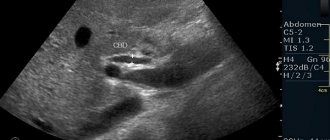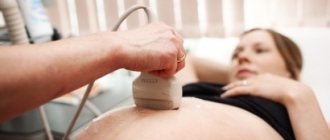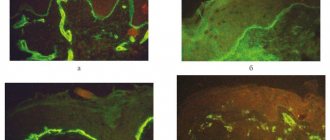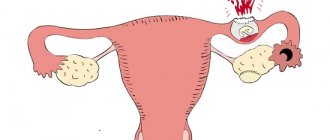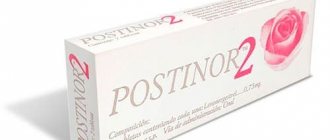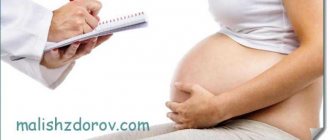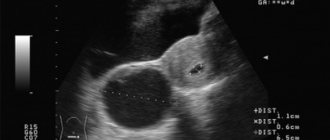The human papillomavirus is one of the most common on earth. There are about 100 types of HPV, but only 80 of them have been studied. Each type has a different degree of danger and causes a characteristic disease.
The most dangerous are those that promote cell degeneration. About 40 types of HPV affect the female genital organs. 30% of women of reproductive age face the problem.
When planning a pregnancy, a thorough examination is necessary to prevent undesirable consequences and spontaneous abortion. HPV is transmitted sexually, although there are cases of domestic transmission.
Why do papillomas appear during pregnancy?
There is no clear answer to the question of why warts (papillomas) appear during pregnancy. To date, it has not been scientifically revealed why growths form on the body, on the neck, labia, in the vagina, in the navel, in the urethra, etc. In medical practice, it is customary to identify the following causes of papilloma during pregnancy:
- Hormonal changes in the body. Human papillomavirus (HPV) infection in this case occurs due to the active production of hormones, which enhances the growth of epithelial cells.
- Injury to the skin as a result of friction with clothing. The growths may appear due to the fact that the expectant mother is rapidly gaining weight. Clothes become small. Most often, growths appear in the armpits, chest and groin areas. The papillomavirus begins to grow, which causes discomfort during pregnancy. As a rule, growths appear in the second and third trimester. Papillomas after pregnancy usually go away on their own.
- Weakening of the immune system and exacerbation of chronic diseases (including HPV). Therefore, if papillomas appear in intimate and other places during pregnancy, this is not surprising.
If a woman has a lot of moles and papillomas, she worries: are they dangerous? The appearance of growths during pregnancy is usually not dangerous. Only discomfort. Therefore, HPV and childbirth are two compatible concepts. However, if the mother is infected, the pathology can pass to the child. The virus is dangerous for the baby. Therefore, treatment if papilloma occurs is mandatory during pregnancy.
If quite a lot of small papillomas appear after childbirth, this is also quite common. The reason for their occurrence is that the body is under stress after pregnancy and the birth of a child. Reviews from women who have gone through this say that the resulting growths will go away on their own after some time.
If papillomas come out after pregnancy and their growth continues for a long time, you need the help of a specialist. He must determine the strain of the virus. If HPV 16, 18, 58 or HPV type 45 is detected, it is life-threatening. Such strains of infection are oncogenic and can develop into cancer.
The appearance of growths during pregnancy is usually not dangerous
When papillomas grow, they are easily injured. As a result, infection may occur in the wound or blood poisoning. Therefore, if the growth has increased, you need to consult a doctor to avoid serious consequences.
Consequences for the fetus and newborn
Papillomavirus and pregnancy are quite compatible if the growths do not form on the cervix or in the vagina. In this case, there is no danger to the fetus. The risk of infection of the embryo is minimal when neoplasms are observed on the surface of the genitals. The negative impact of HPV on pregnancy and the child appears only when a woman has condylomas on the cervix and in the vagina.
The consequences for the child can be serious. He may develop laryngeal papillomatosis. This is a pathological condition in which growths form on the vocal cords, trachea, and mucous membrane of the throat. Complications of the disease can lead to hoarseness and respiratory problems. The pathology is chronic. Its exacerbation can lead to the spread of infection into the bronchi and cause the development of asphyxia.
Infection of a newborn can also occur through medical instruments and hands. It also occurs in the first days of life when fed or touched by infected people. The risk of infection in infants increases with microdamages on the skin and mucous membranes.
Do not despair, although HPV has a negative effect on the fetus, infection through the vertical route (from the mother) is quite rare. In addition, there are a large number of effective drugs that can suppress the pathogen. It is possible to give birth to a healthy child with HPV if you start treatment on time.
It is possible to give birth to a healthy child with HPV if you start treatment on time
Is it possible to get pregnant with HPV?
When a woman is diagnosed with the virus, she may begin to worry: is it possible to get pregnant if infected with HPV? Papillomas on the mucous membranes and on the skin when infected are not an obstacle to conception. You can get pregnant with HPV safely, but the complications that the virus causes can harm female reproductive function.
To avoid this, if papillomas occur in intimate places and in other areas in women with weakened immunity, you need to undergo mandatory diagnostics. The examination is carried out by a gynecologist, endocrinologist, and oncologist. As it became clear, the answer to the question of whether it is possible to conceive children with the virus is positive. However, it is necessary to know what harmful effects the virus has on the mother during pregnancy in case of complications.
Complications of papilloma on the neck and other places during pregnancy affect the female body as follows:
- As a result of pathological changes in the structure of the skin, precancerous conditions and the initial stages of cancer can occur. In the initial stages of cancer development in the cervix, it is still possible to cure it. Therefore, women of fertile age need to be regularly tested for HPV when planning pregnancy and during pregnancy.
- Many strains of the virus do not pose a danger to women. However, condyloma on the genitals and cervix has an adverse effect on the nature of the discharge. Most patients are sure that such changes cannot lead to anything serious, but this is not the case. It is cervical mucus that helps sperm penetrate the uterus and conceive a child naturally.
- If changes in discharge due to HPV do occur, this can cause serious harm. Sperm will not penetrate into the uterine cavity at all. Disturbances in the cervical fluid create an optimal habitat for pathogenic microorganisms. This leads to the fact that pregnancy may not occur. This is how HPV negatively affects the conception of a child. Therefore, the birth of a baby should be planned and accidental proximity should be avoided.
If a pregnant woman is diagnosed with an active form of the pathogen, then the child may become infected at birth or, in rare cases, during fetal development. The question immediately arises: is it possible to give birth with active HPV?
Childbirth with an inactive form of the virus cannot harm the baby
Childbirth with an inactive form of the virus cannot harm the baby. In this case, infection will not occur. The danger is posed by genital warts in the genitals, which are very difficult to detect. The child will become infected when passing through the birth canal. Not all types of HPV can cause infection in a baby. Only births with active papillomas 6, 11, 16, 18 strains pose a threat.
Thus, it turns out that natural childbirth with HPV can only occur with a “dormant” pathogen. In other cases, a caesarean section is performed. Those who gave birth with HPV need to undergo a course of therapeutic measures after pregnancy. How long this will last depends on the individual characteristics of the patient, the type of infection, and the severity of the pathology.
Does the virus threaten the fetus?
A viral infection poses a serious threat to the fetus if it affects the trophoblast, the area through which the embryo comes into contact with the surface of the uterus. Because of this, in the vast majority of cases, spontaneous termination occurs in the early stages. Sometimes a woman may not even know that she was pregnant. Therefore, for patients with recurrent miscarriage, the mandatory list of examinations includes testing for several types of HPV. An infection accompanied by the appearance of condylomas with papillomas is a dangerous disease for pregnant women.
As practice shows, intrauterine infection is practically excluded, but the pathogen affects the immune status. A decrease in the body's resistance leads to infectious diseases that can negatively affect the course of pregnancy.
Infection of a newborn can occur during its passage through the birth canal. If the cervix is affected, pathogens are present on it, then they easily move to the skin and mucous membranes of the baby. Therefore, before giving birth, a woman is prescribed diagnostics: colposcopy, cytology smear.
Detection of the human papillomavirus is not a contraindication for natural childbirth if there are no concomitant diseases. Even when the concentration of the pathogen is high, a woman can give birth on her own. Antiviral treatment is usually not prescribed, since medications for HPV can harm the developing and growing embryo.
Caesarean section for human papillomavirus infection is recommended if there is a serious risk to the baby and the woman’s reproductive tract is affected by atypical cells. Cervical neoplasia is also the basis for using a surgical method of delivery. It is not known how the affected tissues may behave during the natural opening of the external pharynx.
Pregnancy with HPV types 16 and 18
Pregnancy with HPV types 16 and 18 can lead to infection of the fetus. Such strains are dangerous because they are often asymptomatic. Pointed papillomas, which occur with HPV types 16 and 18 in women, are difficult to detect, which means treatment will not be provided in a timely manner. In addition, they are HPV of high oncogenic risk.
HPV types 16 and 18 during pregnancy do not affect the formation and development of the organs of the unborn child. But a pathogenic microorganism can pass to the baby through the birth canal upon birth. From the moment of birth, the child will be a carrier of the virus. At the slightest weakening of the immune system, pathogenic microorganisms are activated and begin to develop. There is a high chance that the infection will outgrow cancer. Therefore, women with HPV types 16 and 18 are recommended to have a cesarean section.
Harmful effects of the papilloma virus on women
HPV, which affects a woman’s genitals, is often asymptomatic, but leads to serious illnesses:
- Cell dysplasia.
- Cervical cancer, etc.
HPV manifests itself in women in the form of papilloma and condylomas (pointed and flat). Papilloma (flesh or pinkish in color) has the shape of a papilla. According to statistics, cervical papilloma is in second place after herpes, which affects the genitals. In 99% of cases of cervical cancer, the root cause is HPV.
Cell degeneration can occur slowly or rapidly. Condylomas are susceptible to this process. Flat condylomas are more dangerous in oncological practice, since they are susceptible to the rapid degeneration of a benign formation into a malignant one.
The papillomavirus has a powerful effect on the immune system, destroying it, which affects the health of the woman, the pregnancy and the health of the offspring. It is possible to become pregnant with HPV, but monitoring is required.
Diagnostics
Papilloma in the bladder and other organs in women is diagnosed as follows:
- visual examination by a specialist and colposcopy;
- lab tests;
- cytological examination;
- histological examination;
- PCR.
The most popular method for detecting papilloma and condyloma in intimate places during pregnancy is the polymerase chain reaction (PCR). It allows you to determine the oncogenicity of the pathogen and its type.
HPV in “position”
Papillomas can be contracted through sexual contact; therefore, there is a risk of transmission of the virus from mother to child during childbirth. A baby passing through the birth canal can get the virus from the mother's blood. To eliminate this possibility, a woman diagnosed with HPV is recommended to give birth by cesarean section.
In addition, throughout pregnancy, such a woman should regularly undergo biopsy and colposcopy to monitor the situation with the progression of the disease, especially if viruses of types 16 and 18 are detected, because they can develop into cancer during pregnancy, when the woman’s body is weakened.
HPV types 16 and 18 appear as neoplasms in the form of low round spots on the skin or on the mucous membrane of the genitals, uterus and fallopian tubes.
The fight against condylomas is carried out only if they really threaten the life of the mother or unborn child. There are several methods for removing condylomas for papillomavirus:
- Laser surgery. During this procedure, the condylomas are burned with a strong laser beam.
- High frequency electric current. This method also allows you to burn condylomas on the skin and mucous membrane.
- Freezing condylomas with liquid nitrogen. In this case, the growths on the skin crumble into dust under the influence of ultra-low temperatures.
- Removal of tumors surgically. Condylomas are simply cut off from the surface of the skin with a scalpel.
Treatment
A pregnant woman, if she has an infection, often does not know what to do or how to get rid of the tumor. Treatment of HPV (human papillomavirus infection) during pregnancy is often not required. As a rule, after childbirth the growths go away on their own. There is no need to treat them specifically.
However, this does not always happen. New growths can grow quickly and cause severe discomfort. In this case, treatment of papillomas and condylomas during pregnancy is necessary. This will help avoid infecting the child.
Papillomas of the bladder and other organs must initially be examined and only then treatment begin
Papillomas of the bladder and other organs must initially be examined and only then treatment begin. Only in this case will effective therapy be prescribed. How to treat the disease in pregnant women is determined by a highly qualified specialist. Elimination of the infection that caused the formation of growths is usually carried out using conservative methods (drugs that are acceptable for pregnant women). In some cases, it may be necessary to remove a tumor in the bladder, cervix, or vagina.
Treatment of papillomas during pregnancy
As medical practice proves, treatment of HPV during pregnancy is not a mandatory action. You should begin medical intervention only if there are changes in the cervix. If the tumors do not progress, it is better to refrain from using excision and all kinds of antiviral drugs. All medications have a detrimental effect on the unborn baby.
After a certain examination of the woman, the nature of the growth will be revealed. If no pathologies are observed, treatment should be postponed until the postpartum period. But then, the baby’s mother will not be able to breastfeed him.
All existing methods of surgical intervention are extremely unsafe for a pregnant woman. Therefore, it is impossible to use such widespread methods of excision as laser therapy or colposcopy (burning out the growth with liquid nitrogen). They are strictly contraindicated during pregnancy.
The development of a viral infection in the body is a consequence of a weakened immune system. All actions to cure pillomavirus in pregnant women involve natural support of the immune system. Some clinics offer ozone drips. This procedure has a significant impact on the immune system. The attending physician will prescribe a vitamin complex, which is essential in stabilizing the body’s functioning.
It is extremely important that pregnant women receive adequate nutrition and rest. In her case, the influence of stressful situations should be excluded. Take care of your health, and nothing will threaten the baby in the womb. Do not self-medicate. This can lead to irreparable consequences. Remember that many drugs have serious contraindications. Your task is not to harm the fetus.
Is it possible to remove papilloma during pregnancy?
Is it possible to remove a papilloma or wart during pregnancy? Pregnant women are often interested in this question. A specialist usually does not remove papilloma of various strains during pregnancy. However, there are situations when they simply need to be removed surgically (if the health or life of the child and mother is threatened).
Removal of growths during pregnancy can be done using different methods:
Removal of growths during pregnancy can be done using different methods.
- laser;
- growths can be cauterized by electrical discharges (electrocoagulation);
- neoplasms are removed with liquid nitrogen;
- surgically.
Thus, the answer to the question whether papillomas can be removed during pregnancy is positive. But this can only be done in emergency cases.
The influence of HPV on pregnancy planning
Infection with the pathogen occurs during intimacy, when hygiene rules are violated. The carrier of the virus is most often a man, but due to the characteristics of the immune system, he may not have external manifestations - condylomas or warts.
The pathogen affects the DNA of cells of the skin and mucous membranes. With a decrease in immune defense, the processes of cell division and cell death are disrupted and vegetation appears. The infection does not penetrate or affect the ovaries, fallopian tubes, and does not affect the processes of formation and rejection of the uterine epithelium.
Pregnancy with a confirmed diagnosis of HPV, including highly oncogenic varieties, is possible.
The presence of a pathogen is not a contraindication for conceiving a child or a reason for abortion. HPV does not penetrate the placenta and does not have a mutagenic or teratogenic effect on the fetus.
If cervical dysplasia is detected, or the presence of atypical cells against the background of HPV, the doctor will recommend abstaining from sexual activity and planning pregnancy for the entire period of treatment.
Treatment and removal after childbirth
As mentioned earlier, treatment for papillomas after childbirth is usually not required. They go away on their own. If papillomas on the neck, face and other places cause discomfort after the baby is born, you need to consult a specialist for HPV treatment. Self-medication can lead to serious consequences.
To treat the infection, the doctor usually uses conservative therapy. Antiviral drugs and immunomodulators are prescribed to strengthen the body's defenses. Medicines are selected based on the individual characteristics of the patient (whether she is breastfeeding, tolerability of the composition, etc.), the type of pathogen and its location.
If the pathology has an oncogenic risk or is located in places that are easily injured, papillomas and condylomas are removed after childbirth. The surgical methods prescribed are the same as during pregnancy. However, they have contraindications. Only a doctor can prescribe them.
Will HPV prevent you from getting pregnant?
The presence of human papillomavirus infection does not affect the possibility of conception and the normal course of pregnancy.
Against the background of infection, local immune defense decreases. The development of dysbacteriosis, inflammatory processes in the reproductive sphere, and mycosis in the vagina is possible. The chance of getting pregnant with human papillomavirus is reduced.
With the active course of papillomatosis with the appearance of vegetations on the external genital organs, the question of possible pregnancy does not arise. The process is accompanied by unpleasant symptoms, pain during sexual intercourse, itching, and decreased secretory function of the mucous membrane, which makes sexual intercourse difficult.
Modern methods of treating HPV involve the prescription of system-wide and local antiviral drugs in the form of suppositories, sprays, and ointments. The formations are removed using minimally invasive techniques. During treatment, sexual activity is prohibited. It is possible to become pregnant naturally only after the end of the rehabilitation period and tissue healing.
Prevention
To avoid pathogen activation during pregnancy, you need to carefully monitor your health and follow the following recommendations:
- avoid hypothermia, overheating, drafts;
- treat concomitant diseases in a timely manner;
- avoid stressful situations and excessive worries;
- eat properly and drink vitamin and mineral complexes;
- spend more time in the fresh air and do moderate physical activity.
If you are one of the small number of people who are not infected with the virus, you need to carefully select your sexual partner to reduce the risk of infection. It is necessary to use protection during sex. You cannot use other people’s things and personal hygiene products.
What should I do if I have been diagnosed with HPV?
If you have been diagnosed with HPV, first of all, find out what type of virus it is. Only some types of HPV pose a potential threat to women's health, and the HPV you are infected with may not be dangerous at all. Ask your doctor which group your HPV infection belongs to and how high the risk is to your health.
Can HPV go away on its own?
Many women wonder whether HPV infection can go away on its own, without treatment. There is irrefutable evidence that our immunity is able to cope with the virus itself.
In most cases, HPV disappears from the body a few months after infection. Only in rare cases does this virus persist in the body for years and cause a particular disease.
Is it possible to have sex if HPV has been detected?
You can be sexually active if you have been diagnosed with HPV.
Is it possible to plan a pregnancy and give birth with HPV?
The presence of HPV in the body does not reduce the chances of successful conception, normal pregnancy and natural childbirth.
If you have high-oncogenic risk HPV and are planning a pregnancy, then you need to see a gynecologist and have a smear for cytology. If cytology results are normal, pregnancy is not contraindicated. If cytology reveals undesirable changes in the cervix, your gynecologist may recommend that you first undergo treatment and then begin planning a pregnancy.
If you have ever had genital warts (condylomas), you may also be planning a pregnancy. The types of HPV that cause genital warts do not affect a woman's ability to conceive a child or successfully carry a pregnancy to term. If you currently have condylomas, you may need treatment. You can read more about this by following the link Genital warts and pregnancy planning.
HPV during pregnancy
The human papillomavirus in a pregnant woman does not pose a threat to the unborn child. This virus cannot cause birth defects in the fetus and does not increase the risk of miscarriage, premature birth or other complications.
The risk of the virus being passed on to a child is extremely low. Even if a child becomes infected with HPV from his mother, his body usually successfully copes with this infection. At the moment, the presence of HPV in a pregnant woman’s body is not an indication for a cesarean section.
If during pregnancy HPV causes undesirable changes in the cervix, you may need more careful monitoring by a doctor (regular smears for cytology, colposcopy). Typically, treatment for HPV is not performed during pregnancy because the medications used for treatment may have adverse effects on the health of the fetus.
If HPV causes genital warts, you may also need closer medical supervision. During pregnancy, condylomas can grow to large sizes and periodically bleed. As a rule, treatment of condylomas is postponed until after childbirth, but in exceptional cases treatment may be required urgently.
Treatment of HPV in women
Most women who find out that they are infected with HPV ask the same question: “Do I need treatment, and if so, how?”
The answer to this question depends on several factors:
- Do you have any symptoms of infection?
- Do you have any changes in the cervix based on the results of a cytology smear?
If you have been diagnosed with HPV, but there are no symptoms of infection and cytology is normal, then no anti-HPV treatment is required. It is not required because in 90% of cases the virus disappears from the body on its own a few months after infection. It is impossible to cure HPV (get rid of it with the help of medications): it will either disappear on its own due to the work of the immune system, or it will remain in the body and possibly cause some diseases.
If you have been diagnosed with HPV and it has caused the appearance of genital warts, then you need treatment (cauterization). On our website there is a separate article dedicated to Condylomas and their treatment.
If you have been diagnosed with HPV and it has caused undesirable changes in the cervix, then you may also need treatment (cauterization or removal of damaged areas of the cervix). On our website there are separate articles devoted to Cervical Dysplasia and Cervical Cancer.
Antiviral drugs and immunomodulators in the treatment of HPV
Various medications can be used to treat an HPV infection that has already caused symptoms. Most of these drugs have an antiviral effect (that is, they fight viruses) and an immunomodulatory effect (that is, they strengthen the strength of our immunity in the fight against HPV).
It should be borne in mind that the need for the use of these drugs in the treatment of HPV has not yet been proven, and their effectiveness is questionable. None of these drugs appear in international recommendations for the treatment of HPV infection. Apparently, this is due to the unproven effectiveness of these agents.
Inosine pranobex for HPV (trade names: Isoprinosine, Groprinosin) - prevents further reproduction of viruses in the body and increases immunity. It is used primarily in the treatment of genital warts (condylomas), but can also be effective for other symptoms of HPV infection.
Interferons and interferon inducers for HPV (Genferon, Cycloferon, Viferon, Lavomax) are immunomodulatory (immunostimulating) drugs that help our immune system fight against HPV, as well as against some other viruses and microbes. They can be prescribed as part of therapy for genital warts, genital herpes, chlamydia, mycoplasmosis, cervical erosion and other diseases.
Dietary supplements, dietary supplements for HPV (Indinol, Epigallate) - can have a general strengthening effect on the body, increase the strength of the immune system in the fight against viral infections (including against HPV). They can be recommended as part of complex therapy for cervical erosion, cervical dysplasia, as well as for condylomas (genital warts).
Panavir for HPV is a medicine that contains potato shoot extract. Panavir has an immunomodulatory effect, as it increases the body's resistance to various viruses, including HPV and genital herpes virus. It can be prescribed as part of complex therapy for genital warts caused by HPV.
Immunal for HPV is a herbal medicine (contains Echinacea purpurea extract), which has an immunostimulating effect. Increases the body's defenses and can accelerate the elimination of HPV from the body.
Polyoxidonium for HPV is a medicine that has an immunomodulatory effect and can be prescribed as a treatment and prevention for a wide variety of infections. Polyoxidonium in suppositories (candles) can be recommended as a treatment for cervical erosion, cervical dysplasia and genital warts.
Derinat for HPV - has a general strengthening and immunostimulating effect on the body, helps in the fight against various viral infections, including against HPV.
Ferrovir for HPV - has an antiviral effect against papillomavirus, genital herpes virus, cytomegalovirus and some other viral infections. Helps improve immunity by accelerating the elimination of viruses from the body. Can be recommended for cervical dysplasia. Prescribed as intramuscular injections.
Alloferon, Allokin-Alpha for HPV is a medicine that has an immunostimulating effect that can accelerate the elimination of the human papillomavirus from the body. Allokin-Alpha can be part of a complex treatment for cervical erosion, cervical dysplasia, if tests have revealed the presence of one or more oncogenic types of HPV.
Allomedine gel for HPV – has an antiviral effect, preventing the proliferation of viruses at the sites of application. This product is available in the form of a gel, which must be regularly applied to damaged areas of the skin (in the area of warts, skin papillomas, condylomas). It can also be used to prevent the reappearance of warts or condylomas after their removal.
Epigen intimate spray for HPV - accelerates skin healing after removal of warts and condylomas, prevents the reappearance of symptoms of HPV infection, has an antiviral and immunomodulatory effect.
Medicines that are not effective for HPV
Some antiviral medications have no effect on HPV infection, so their use in the fight against papillomavirus is not recommended. Drugs such as Acyclovir, Famciclovir (Famvir), Valtrex are not used in the treatment of HPV, since they are not able to affect this virus.
Treatment of the virus
Treatment of human papillomavirus does not guarantee complete relief from this disease. It must be remembered that there is no one correct course of therapy, after which a complete cure occurs. Medications, like other treatment methods, are selected taking into account the individual characteristics of the body. Particular care should be taken in selecting medications during pregnancy.
Treatment of HPV types 16 and 18 during pregnancy is carried out with the utmost care so that medications do not have a negative effect on the fetus. An approximate treatment regimen consists of prescribing several groups of drugs that reduce the impact of the virus on the body and strengthen the defenses. Therapy is carried out in three stages:
aimed at restoring the microflora of the affected vagina.
The use of non-steroidal anti-inflammatory drugs,- Strengthening and restoring the body's immune forces with the help of interferon. Preparations based on it promote the production of T-lymphocytes, which fight mutated cells.
- Prescription of nonspecific antiviral drugs and complexes, which are vitamins E, C, B6.
In the treatment of human papillomavirus, it is necessary to select a suitable set of drugs that will affect not only the virus, but also the cause of its appearance. It is advisable to take medications that strengthen the immune system, because... the virus progresses to a greater extent due to its decrease. During pregnancy, it is better to refrain from using strong medications to avoid negative consequences for the child.
Papillomas on the body can be removed only after a full examination and permission from a doctor. Neoplasms without a clear clinical picture and not threatening to develop into a cancerous process are best left and removed after the birth of the child.
Radical treatment as prescribed by a doctor is divided into several ways:
Surgical removal of papillomas from the surface of the body.
This type of treatment is applied to large growths; surgery is painful and requires more recovery time. It is possible to use a laser; it is more effective and does not cause complications.
Electrocoagulation is the removal of papillomas by applying electric current to them.
When carrying out this procedure, the pathological formation is burned out. As a result, no genotype-altered tissue remains at the intervention site. There is no bleeding or inflammation.
The effect of liquid nitrogen on neoplasms is cryodestruction.
The essence of this method is to freeze cells and then cause them to die. This type of procedure is especially effective against HPV type 18. The advantage of this method is that there is no need for painkillers.
Chemical coagulation
The simplest method of combating papillomas. Before using it, it is necessary to know exactly the nature of the neoplasm. A small crust remains at the cauterization site, which should come off on its own. If it fails, bleeding and scar formation occurs.
The use of folk remedies for removing papillomas from the body during pregnancy, as well as the use of other methods of combating them, is best postponed until the birth of the child. If they do not bleed, become inflamed, or increase in size, postpone these procedures.
Folk methods of combating neoplasms include the use of celandine juice or extract, as well as iodine. These products should be applied several times a day to the stalk of the papilloma. The duration of use of folk remedies depends on the severity of the disease.
Treatment of pregnant women
Typically, a person is prescribed a number of antiviral drugs to combat the virus. However, such drugs have an extremely negative effect on the body of the expectant mother; the woman may even develop thrush, which will only worsen the situation with the infection. It is also not recommended to remove emerging condylomas using various methods, since the anxiety experienced during the procedure can adversely affect the child’s health.
In this regard, only immunostrengthening therapy is used. That is, the body is helped in its fight against the virus, and as soon as childbirth passes, you can begin to treat the woman with other medications. However, if she wants to breastfeed her child, then drug treatment will have to wait.
Disease prevention
To ensure that HPV during childbirth does not interfere with the birth of a child and does not expose his mother to the risk of cancer, it is necessary to apply preventive measures. Since the virus can be contracted during unprotected sex, such contacts should be avoided, especially since they can also result in other dangerous diseases such as herpes, syphilis or AIDS. It is best to have a permanent relationship with one trusted partner.
In addition, you should never use other people's personal hygiene products: razors, toothbrush, comb, scissors, towel, etc. The same goes for dishes, especially in public places.
And in order to strengthen your immune system, you need to:
- Eat right, exclude spicy, fatty and fried foods from your diet. Although nutritionists believe that you can eat fried meat, this is true only if it is lean and the preparation of the dish does not require a large amount of oil. You should include fresh fruits, vegetables, nuts, honey and fresh juices in your diet.
- Give up bad habits - smoking, drinking alcohol and especially drugs.
- Exercise regularly, take walks in the fresh air more often, walk, be in nature.
To the above, you can add regular medical examinations - at least once a year, regardless of whether pregnancy is planned or not. Be healthy!
